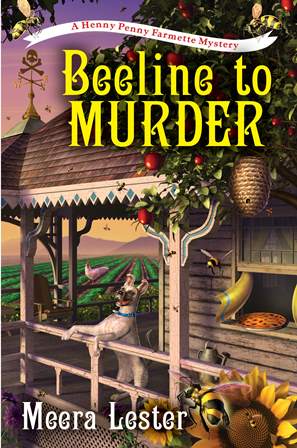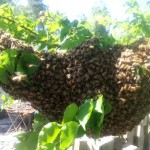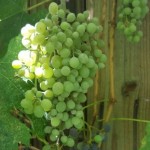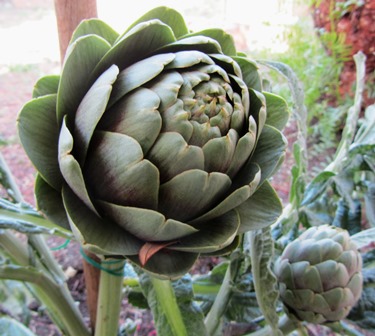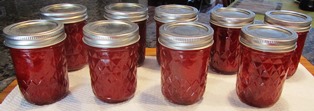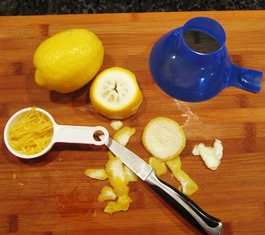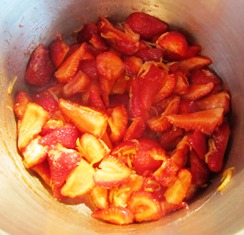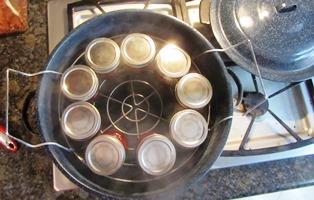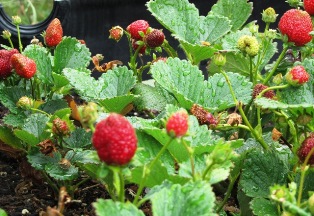Enjoy Seasonal Fruit Year-round
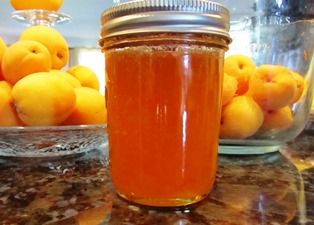
In the Bay Area, strawberries, blueberries, and early varieties of plums ripen in the spring. By the start of summer, a lot of stone fruit is available. Look for apricots and peaches and later varieties of plums during early June through July. Find peaches and nectarines by mid-August.
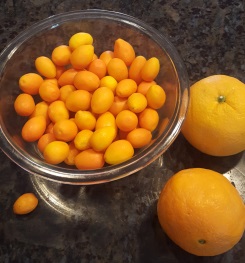
for winter marmalade
The end of the stone fruit heralds the arrival of late-summer pears. Local suppliers offer these fruits at farmers’ markets and to stores throughout the harvest period so buyers can be assured of fruit quality and freshness.
To preserve your favorite summer stone fruit, you have several options. Hot-water canning supplies come in handy for preserving fruit into jam, jelly, marmalade, and conserve. A dehydrator produces dried fruit and leathers. Finally, some fruits can be made into jam or marmalade and refrigerated for use over a week or two or frozen.

As summer nears its end, look for a large variety of pears and persimmons to show up on store shelves. Then, as the winter holidays near, citrus (oranges, kumquats, lemons, and limes) begin to ripen and can be preserved into a soft spread such as a conserve, jam, or marmalade.
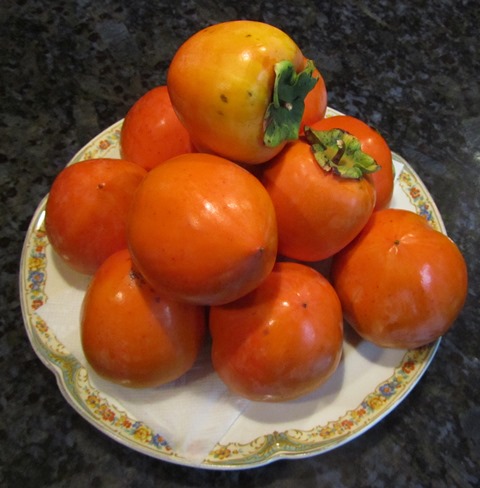
If country living topics interest you and you enjoy a good mystery with recipes and tips for keeping chickens and bees, check out my Henny Penny Farmette series of cozy mysteries, informed by my real-life farmette experiences.
The novels include A BEELINE TO MURDER, THE MURDER OF A QUEEN BEE, and A HIVE OF HOMICIDES. All are available online or wherever books are sold.
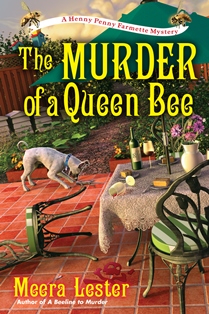
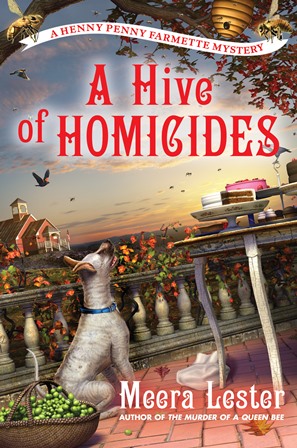
Three Reasons to Plant Bare Root
If you are someone like me who loves to garden, you have the first day of spring circled on your calendar. For 2020, spring arrives on March 19.

Plant bare root fragrant roses and engage in mindfulness practice. Both will have you stopping to smell the roses
Bare-root season (when fruit trees, roses, and other plants are dormant and sap is not flowing) is now. Here in the Bay Area, the soil is currently soft and makes for easy turning with a spade. Now is the time to incorporate some roses or other bare root plants into your garden. There are several reasons to do so.
1. Planting bare root saves you money. If you are buying from a local nursery or a seller who ships, you’ll find the cost cheaper because you’re not paying for soil or containers.
2. Better selection. You can purchase heirloom varieties of deciduous trees and shrubs from all over the world when you buy bare root. Bare root fruit trees are popular with back yard gardeners but you might also consider artichokes, rhubarb, strawberries, grapes, asparagus, and many other plants that are sold as bare root.
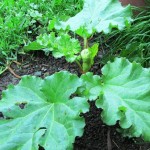
Rhubarb is a bare root plant that flourishes in rich soil with some protection against direct overhead sun
3. You have flexibility. Planting in February just before spring means the ground has thawed in areas where freezing temperatures are the norm. When the ground is growing warmer and is workable is the time to tuck your bare root plants into the soil.
________________________________________________________________________
If you enjoy reading about country living topics, check out my Henny Penny Farmette series of cozy mysteries, including A BEELINE TO MURDER, THE MURDER OF A QUEEN BEE, and A HIVE OF HOMICIDES (Kensington Publishing). These mysteries also include farm to-do lists and delicious recipes.
I’ve also written over two dozen self-help and wellness books, including THE SELF-CARE PLANNER, HOW TO LIVE WITH INTENTION, and MY POCKET MEDITATIONS (Adams Media/Simon and Schuster).
Find Meera Lester’s books online and in traditional bookstores everywhere. Barnes & Noble will be featuring THE SELF-CARE PLANNER on its self-care table for the New Year, New You promo, starting Dec. 31 and running through March 2020, in select stores.
https://www.simonandschuster.com/books/The-Self-Care-Planner/Meera-Lester/9781507211649?utm_source=author_post&utm_medium=adams_outlet&utm_campaign=adams_lead_fall&utm_content=
Springtime Projects on the Farmette
After weeks of rain, Mother Nature has put on a robe of splendor. Warm weather has arrived. Already, my beekeeper neighbor has had his honeybee hives send out three swarms.
My own bee population seems to be swelling. I’ve fished out my swarm catcher, primed it with scented lemon oil, and placed in among the blossoms in a nearby apricot tree. I may be blessed with a swarm as well.
There are plenty of other springtime projects to attend to here on my farmette. I’ve got to reassemble my temporary grape arbor. Each year, I think we’ll build a permanent structure, but there never seems to be enough time.
My cell flats have organic plants up now and ready for placing in my garden or raised beds. I’d like to add some more chicken manure to the strawberries since they are rapidly growing and producing small fruit.
Other plants need a spring feeding–the citrus, apples, and apricots, for example. I usually do the feeding before the trees break bud, so I’m a little late.

This candy-stripe rose was a gift from a friend–a cutting from her rose that became a large bush in my care
I will be turning the compost pile and mulching all my rose bushes (which have already leafed out and are setting buds). Finally, I’d like to put up a couple more bird houses (mating is already in the air) and fill my hummingbird feeders.
- This–my original flock–was massacred by a wild predator, fox or coyote, last year
I need to purchase baby chicks from the feedstore to start my new flock. Hubby and I will build a new, reinforced chicken run and expand the existing hen house.
Then, there’s the side walkway that needs pavers. Painting of the fences. Building a new porch. Widening the patio…the projects are seemingly endless, but that’s fine. We’ll have a lovely six months (maybe an occasional storm). The dry season is upon us.
And I’m ready for the Adirondack chair…oh, that’s right…we have to build it first!
_________________________________________________________________
If you enjoy reading about farming topics and you love a good cozy mystery, check out my novels from Kensington Publishing–A BEELINE TO MURDER, THE MURDER OF A QUEEN BEE, and A HIVE OF HOMICIDES. All are available on Amazon.com, Barnes & Noble.com, and other online retailers as well as in bookstores everywhere.
Growing Your Own Superfoods
Nutrient-rich fruits, vegetables, and berries are not difficult to grow. Some can even be grown in containers on a sunny patio. My favorite superfoods include blueberries, strawberries, raspberries, and blackberries as well as artichokes, assorted leafy greens, and figs. But in general, superfoods are those foods rich in nutrients, vitamins, fiber, antioxidants, and/or omega-3 and omega-6 fatty acids.
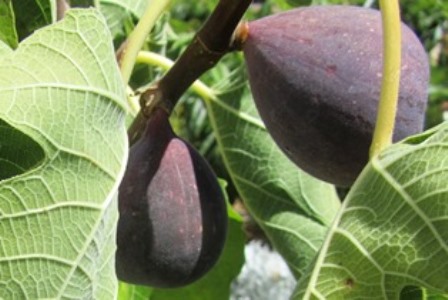
The dark purplish color is characteristic of the brown turkey fig, and this tree needs a lot of space in the garden
On the farmette, I’ve planted several fig trees that are semi-dwarf and include White Genoa, Brown Turkey, and Mission varieties. These trees produce two crops each year–one in spring and the other in the fall. The fruits can be dried or eaten fresh and contain omega-3 and omega-6 fatty acids and phenol for the prevention and treatment of coronary heart disease.
I’ve planted raised beds of strawberries, including Albion, a variety that produces berries from June to October, and Sequoia, a dependable berry that produces fruit from June to early frost.
In half barrels, I’ve amended soil and planted thornless raspberries and blackberries. I like growing them in containers with trellis support because otherwise they spread all over any area of the garden where they’re planted.
We planted one artichoke a couple of years ago. It dies back in late fall only to return in the spring as a new plant with shoots containing the small chokes. Artichokes are low in calories and aid in the lowering of cholesterol because of specific compounds found in the edible parts of the plant.
Early in the spring when I put in my sweet garden peas, I also plant leafy greens such as kale, collards, lettuces, and spinach. Some of these come back the next year after their growing season is over.
Blueberries are easy to grow when you remember to plant them in acid soil. These berries are considered a superior brain food. They are low in calories (84 calories per cup) and provide about 24 percent of the suggested daily amount of Vitamin C that the body needs.
Except for the fig trees and the artichokes that do better in areas of the garden where they have plenty of space to spread, the other nutrient-rich foods mentioned can all be planted and raised in containers. It’s so easy to grow most of these plants, why not give it a try.
Backyard Fruit Compote
Who feels like eating when the shorts and sandals weather has turned hot enough to warrant wearing bikini bottoms and thin cotton T-shirt for doing your household chores? Bring on the cool summer salads.
When the temperatures hit 105 on the farmette yesterday, we opted for a simple supper of cold chicken, orzo with Italian vinegar and oil dressing, and cold potato salad.
With nectarines and peaches ripening now on our trees, blueberries finally sweet enough to eat, and strawberries available at our local farmers’ market, what could be better for a dessert on a hot summer’s evening than a fruit compote.
Recipe for Backyard Fruit Compote
Gather the fruit, including nectarines, peaches, plums, strawberries, blueberries, kiwi, and melon.
Wash, and slice the nectarines, peaches, plums, and strawberries.
If including melon in the compote, scoop the melon into ball shapes using a melon baller or cut pieces of melon into cubes.
Peel and slice the kiwi.
Toss all into a bowl, adding the blueberries.
Sprinkle lightly with a scented sugar, or a super fine sugar, or honey.
Or, make a dressing: mix together 1/4 cup of lime juice, 1/4 cup of honey, 1 teaspoon of orange zest, 1 teaspoon of lime zest, and 1/2 teaspoon finely grated ginger. Pour over the fruit. Chill for about 1 hour and add springs of mint before serving.
Drying Fruits Naturally
I love dried apricots, but don’t tolerate well the ones treated with sulfur dioxide(used to prevent oxidation and loss of color). With so many apricots on our property coming ripe at once, I have decided in addition to making jam this year to also dry some of the fruit.
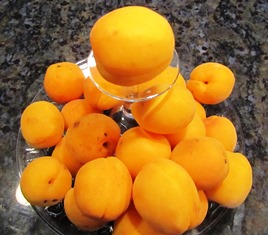
Apricots, so plentiful this time of year, are easy to dry and make great snacks when the season is over
Apricots dried but not treated with sulfur dioxide will turn a natural brown color. Some stores sell them this way. They are usually priced the same or similar to the treated apricots with the bright orange hue.
Besides apricots, other fruits that dry well include apples, bananas, cherries, grapes, nectarines, peaches, pears, plum, rhubarb, and even strawberries. You can use a drying machine
Quick Tips for Drying Fruit
1. Choose to dry only the freshest picked fruits, without bruises, scale, sun scald, or other blight.
2. Spray nonstick vegetable spray on drying pans or trays to make it easier to remove the dried fruit
3. Lay out the fruit to dry in a single layer on trays. Remember to rotate the trays occasionally and turn the pieces from time to time.
4. Destroy any insects (miniscule or otherwise) by freezing or baking the fruit. Simply take the tray and stick it into an oven heated to 175 degrees Fahrenheit for about 15 minutes. Alternatively, pack the dried fruit in freezer bags and freeze for at least 2 days.
5. Freezing dried fruit in resealable freezer bags will preserve its shelf life.
Simple Strawberry Jam
I visited the Clayton Valley Farmer’s Market on Saturday and picked up six baskets of large strawberries trucked up from Watsonville, about a two-hour drive from my farmette.
Of the various cities claiming to be the strawberry capital of the world, Watsonville surely must rank as number one because it produces tons of berries to support its claim–California produces eighty percent of strawberries in America. Many, if not most, come from Watsonville.
Those berries in the green plastic baskets at the farmer’s market were huge and delicious and sweet. Perfect for making into jam. Strawberry jam, seemingly, is everyone’s favorite, and this year I’m making some extra batches.
The recipe is quite simple, with only five ingredients.
STRAWBERRY JAM
Ingredients:
6 1/2 cups of washed, sliced strawberries (about 2 quarts, plus a little more)
1/4 cup thinly sliced lemon peel
7 1/2 tablespoons powdered pectin
1 tablespoon of lemon juice
6 cups granulated sugar
Directions for Preparing Jars:
Place nine jars in the dishwasher.
Simmer the rings and lids in a skillet on low heat.
Fill the hot-water canner with water enough to cover the jars by two inches. Bring the water to a boil.
Directions to Make Jam:
Slice the lemon peel off and remove any remaining white membrane from the peel.
Slice the lemon peel into thin strips.
Place lemon peel in a small pan, cover with water, and boil for five minutes.
Drain the water off the lemon peel.
In a large pot, combine lemon peel, strawberries, pectin, and lemon juice. Bring to a boil.
Stir in the sugar until it is dissolved and then bring the pot to a roiling boil.
Boil hard for 1 minute, stirring constantly to avoid the jam sticking to the bottom of the pan.
Remove the jam pot from heat and skim off any foam as needed.
Remove the jars from dishwasher and turn upside down on a paper towel. Before filling the jars, wipe around the jar mouth to remove wetness and turn upright to fill.
Ladle the hot strawberry jam into each jar, leaving 1/4-inch head space. Wipe any jam spilled on the jar lip that might void a good seal. Then set the two-piece caps in place and screw tight. Process in the hot-water canner for 15 minutes. Makes 9 jars.
Working the Beds after the Weekend Storm

A “Pineapple Express” rainstorm with gale-force winds blew out the power and made for slick roads as well as ponds in our clay soil
The weekend storm is still a vivid memory, what with the fence along one side of my property beaten down by high winds and pounding rain that also brought a power outage on Friday night.
But today with outside temperatures in the 70s Fahrenheit, I cleaned my strawberry beds. Somehow, mint had crept in and I don’t want mint with my berries although I like it served that way for dessert.
My neighbor’s relative, who’s visiting from Lebanon where they grow apples in his mountain village, share a suggestion for digging dried chicken manure around the bases of my trees. The high nitrogen will get them off to a great start and my trees have already broken bud (which is attracting the honeybees).
The wild bird population seems to have exploded and I see signs of nest building starting. The five suet cakes I hung in trees for the songbirds, blue jays, and woodpeckers last month are down to a fraction of their original size.
I extended the chicken run with poultry wire high enough to keep the my heritage girls from flying out. Now, they’ll have plenty of space on both sides of the chicken house to forage and out the beds I’m working.
Try Having a Cup of Tea with These Dogs
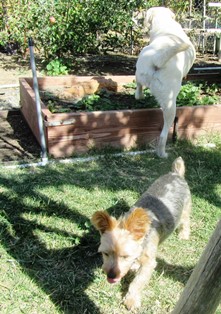
Remington, the white, short-haired lab, is trouncing over the strawberries, while Moose has his sights set on the chickens
I just wanted a nice cup of tea and to sit on the grass and sip it while listening to the birds and watching my bees and chickens. Fat chance. It would take five minutes flat for my daughter’s little dog Moose to knock over the cup, spill the tea all over me, and then traumatize my chickens so badly that their egg-laying is now out of wack; they’re just squatting and dropping.
As a favor to my lovely daughter and her family, I agreed to dog sit on my farmette for four days. My daughter assured me the two family pets would enjoy four days of freedom to romp around our acreage despite one of her dogs being a little high strung. His breed used to chase rats, she said. I didn’t make the correlation. It didn’t seem to matter then.
I reminded her that my bees and chickens both forage freely over the land. The chickens would necessarily have to remain in their chicken run during that period since the dogs might chase them. The bees probably wouldn’t bother the dogs, but I’d take the name of her vet, just in case. Of course, the dogs might not actually like it here.
In retrospect, I believe I underestimated my concerns. Oh, the dogs seem happy enough; it’s my sanity I’m worried about.
The Irish lab named Remington has had some professional training. He is a lovely, well-behaved gentleman. I enjoy him and wish I could same the same for the small dog with the mighty name of Moose who is high-strung, has allergies, and arrived with special gluten-free food, his round bed, and a bag of medications, including a vet-prescribed tranquilizer.
Moose barks a lot. It’s an annoying high-pitched bark. In the yard yesterday, when he wouldn’t stop, I heard my neighbor barking back . . . and that’s just ridiculous!
I thought Moose was going to have a meltdown when he discovered the chickens, barking at the highest decibel he could muster, running the length of the chicken run in one direction with the chickens one step ahead on the inside their poultry-wire pen before hitting the wall where the dog and chickens reversed their direction.
I got half as many eggs yesterday and found two on the ground instead of in the nesting boxes. When the chickens free-range, they always return to the nesting boxes in the hen house to lay their eggs. It’s like they got so scared, they forgot not only where to go but how to properly lay their eggs. I hope things return to normal when the dog visit is over.
I decided to spend the day outside, doing chores like digging planting holes at the front of the property. Moose saw it as a game so as soon as my back was turned, he refilled the holes, pawing like a dog on a mission. I finally gave up on that. The shovel and rake seemed to scare him, so I put those away. And he didn’t like me playing ball with him or the other dog. So we quit on that, too.
By the day’s end though, both dogs seemed tuckered out. Both wanted to sleep in our room. The big dog contented himself in his bed on the floor (by my husband’s side of the bed), but the high-maintenance Moose threw himself onto my pillow, pulled my fleece bathrobe over his head, and nodded off like he owned the place.
When our alarm went off at four o’clock as it does every weekday morning, the yip-yip-yipping and chaos started all over again. Only three more long days and nights left.
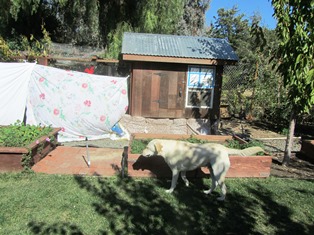
Remi wasn’t the problem but with Moose frightening the chicken feathers off my hens, I draped the chicken run in sheets
I’m going to need a vacation when these four days are over. I just hope my chickens will resume their egg-laying schedule once I take the sheets down off the chicken run (I hung them so Moose couldn’t see the chickens) and I have the energy and some decent weather ahead to re-dig those planting holes. I look forward to having a cup of tea again, too, while I listen to the birds and quiet clucks instead of that shrill yip-yip-yip, amplified by by neighbor’s imitation of it. Ridiculous!
Easy Strawberry-Rhubarb Jam

Rhubarb takes up a lot of garden because of its big leaves but the canes pair well with strawberries
Rhubarb and strawberries just seem to go together. Their flavors blend nicely, whether in a compote, trifle, pie, or jam. The following is a simple recipe for strawberry-rhubarb jam and uses the boiling hot water bath to preserve the jars of jam.
Make extra to tuck into holiday gift baskets or for gift-giving throughout the year.
Ingredients:
2 cups strawberries (washed, hulled, and crushed)
2 cups rhubarb (roughly four stalks, chopped)
1/4 cup lemon juice
6 Tablespoons Classic Pectin
5 1/2 cups sugar
Directions:
Combine the first four ingredients (strawberries, rhubarb, lemon juice, pectin) in a large pot.
Bring to a boil.
Add the sugar, stirring to blend completely.
Return the mixture to a roiling boil.
Time for one minute, stirring constantly.
Remove the pot from heat.
Skim away the foam.
Ladle the jam into hot, clean jars, leaving 1/4 inch head space.
Apply and tighten the two-piece ring/lid caps.
Place jars into the boiling water bath canner.
Process for 10 minutes.
 Facebook
Facebook Goodreads
Goodreads LinkedIn
LinkedIn Meera Lester
Meera Lester Twitter
Twitter





